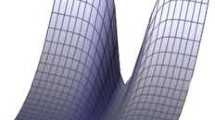Abstract
We present some properties of functions in suitable Sobolev spaces which arise naturally in the study of the motion of a rigid body in compressible and incompressible fluid. We relax the regularity assumption of the rigid body by allowing its boundary to be Lipschitz. In the case of a smooth rigid body we obtain a new estimate on the angular velocity. Our results extend and complement related results by V. Starovoitov and moreover we show that they are optimal. As an application we present an example where the rigid body collides with the boundary with non zero speed. Finally, we present a new non collision result concerning a smooth rotating body approaching the boundary, without assuming any special geometry on either the body or the container.
Similar content being viewed by others
References
Alvarado, R., Brigham, D., Mazya, V., Mitrea, M., Ziade, E., On the regularity of domains satisfying a uniform hour-glass condition and a sharp version of the Hopf-Oleinik boundary point principle. Probl. Mat. Anal. 57, 3–68 (2011)
Adams, R.A.: Sobolev spaces. Academic Press (1975)
Balinsky, A.A., Evans, W.D., Lewis, R.T.: The analysis and geometry of Hardy’s inequality. Universitext, Springer, xv, 263 pp. (2015)
Boilevin-Kayl L., Fernández M. A., Gerbeau J. F., A loosely coupled scheme for fictitious domain approximations of fluid-structure interaction problems with immersed thin-walled structures SIAM Journal on Scientific Computing, 41(2), 351–374 (2019)
Feireisl, E., Hillairet, M., Necasova, S., On the motion of several rigid bodies in an incompressible non-Newtonian fluid, Nonlinearity, 21, 1349–1366, (2008)
Gérard-Varet D., Hillairet, M., Regularity issues in the problem of fluid structure interaction, Arch. Rational Mech. Anal., 195, 475–407, (2010)
Hillairet, M., Lack of collision between solid bodies in a 2D incompressible viscous flow, Commun. Partial Differ. Equations, 32(9), 1345–1371 (2007)
Hoffman K.–H., Starovoitov V. N., On a motion of a solid body in a viscous fluid. Two dimensional case, Adv. Math. Sci. Appl., 9(2), 633–648, (1999)
Lacave, Ch., Takahashi, T., Small Moving Rigid Body into a Viscous Incompressible Fluid, Arch. Rational Mech. Anal., 223, 1307–1335, (2017)
Starovoitov, V.N.: Nonregular problems of hydrodynamics. Novosibirsk State University 2000, Doctor of Sciences, Thesis 230 pp. (in Russian)
Starovoitov V. N., Behavior of Rigid Body in an Incompressible Viscous Fluid near a Boundary, Int. Series of Numerical Math., 147, 313–327. (2003)
San Martin J.A., Starovoitov V. N., Tucsnak M., Global weak solutions for the two-dimensional motion of several rigid bodies in an incompressible viscous fluid, Arch. Rational Mech. Anal., 161, 113–147, (2002)
Takahashi T., Existence of strong solutions for the problem of a rigid-fluid system, C. R. Math. Acad. Sci. Paris 336(5), 453–458 (2003)
Temam, R.: Problème mathématiques en plasticitè, Mèthodes Mathématiques de l’Informatique, 12. Publié avec le concours du C.N.R.S. Paris: Gauthier-Villars. Bordas. VII (1983)
Author information
Authors and Affiliations
Corresponding author
Ethics declarations
Conflict of interest
The authors declare that they have no conflict of interest.
Additional information
Communicated by D. Gerard-Varet
Publisher's Note
Springer Nature remains neutral with regard to jurisdictional claims in published maps and institutional affiliations.
Appendix
Appendix
We recall that
We then have
Lemma 7.1
Let \(p \ge 1\) and \(0 \le \alpha \le 1\). Then, for \(\varvec{u}\) as defined in (5.2) there holds
In addition, the following local estimates hold true for \( p \ge 1\)
where \(\mathcal {G}_{h, \sigma _0}\) is defined in (4.12) and \(\Pi _{h}\) in the proof of Theorem 4.3.
Proof
For
we have that
A straightforward calculation shows that for \(i,j=1,2\)
We then compute, for \(\gamma >0\) small enough but fixed
To estimate the integrals above we use the fact that for \(0 \le \alpha \le 1\) and \(b, q \in I \! \! R\) we have
We then get after elementary manipulations
We similarly calculate for \(i=2,3\)
Combining the estimates of \(I_i\), \(i=1,2,3\) and noticing that the omitted terms in (7.5) are not as important we conclude (7.2). Estimate (7.1) is similar and simpler. \(\Box \)
Rights and permissions
About this article
Cite this article
Filippas, S., Tersenov, A. On Vector Fields Describing the 2d Motion of a Rigid Body in a Viscous Fluid and Applications. J. Math. Fluid Mech. 23, 5 (2021). https://doi.org/10.1007/s00021-020-00528-0
Accepted:
Published:
DOI: https://doi.org/10.1007/s00021-020-00528-0
Keywords
- Sobolev spaces
- Fluid solid interaction
- Estimates on angular speed
- Non zero speed collision
- Non collision



